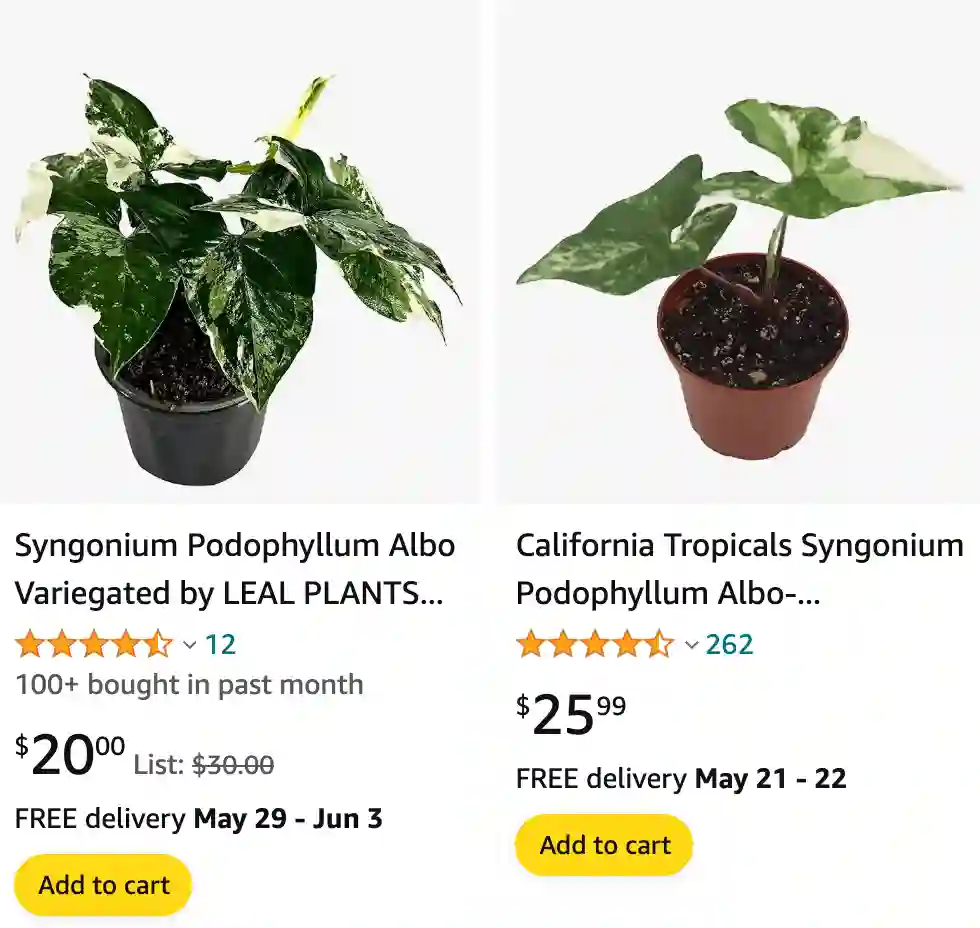
Syngonium albo vs 3 kings
My Syngonium albo is a showstopper. The huge, white leaves splashed with emerald green are like living works of art. It’s a bit fussy, though. I have to be extra careful not to overwater it, or those pristine white patches turn yellow. But when it’s happy, the albo puts on a stunning display. Syngonium 3 Kings, on the other hand, is a trooper. Its marbled green leaves are gorgeous in a more subtle way, and it seems to shrug off occasional neglect. It’s perfect for those days when I forget to check on my plants.
Syngonium albo vs aurea
The albo and aurea are both high-maintenance divas in my collection. The albo’s white variegation needs bright, indirect light to thrive, while the aurea’s sunshine-yellow leaves can scorch easily. The albo’s white parts are more prone to browning if the humidity drops, while the aurea seems less fussy about moisture. Honestly, they both keep me on my toes! But the albo’s stark contrast of white and green wins me over. Syngonium aurea‘s golden glow is undeniably beautiful, but for sheer drama, the albo takes the crown.
How to propagate syngonium albo?
Propagating Syngonium Albo can be done through stem cuttings:
- Select a Healthy Stem: Choose a healthy stem with several leaves, preferably with at least one node.
- Take Cuttings: Use clean, sharp scissors or pruning shears to cut the stem just below a node. Cuttings should be about 4-6 inches long.
- Prepare Cuttings: Remove any lower leaves from the cutting to expose the nodes. This is where roots will emerge.
- Rooting: Place the cuttings in water or a well-draining potting mix. Keep them in a warm, humid environment with indirect light.
- Transplanting: Once roots have developed, transplant the cuttings into individual pots or combine them in a single container for a fuller appearance.
How to care for syngonium albo?
To care for Syngonium Albo, follow these guidelines:
- Light: Provide bright, indirect light. Avoid direct sunlight, which can scorch the leaves.
- Watering: Keep the soil consistently moist but not waterlogged. Allow the top inch of soil to dry out between waterings.
- Humidity: Maintain high humidity levels. Mist the leaves regularly or use a humidifier to mimic its natural tropical environment.
- Temperature: Keep the plant in a warm environment, ideally between 60-80°F (15-27°C).
- Soil: Use a well-draining potting mix rich in organic matter.
- Fertilizing: Feed the plant with a balanced liquid fertilizer diluted to half strength every 4-6 weeks during the growing season.
- Pruning: Prune regularly to maintain shape and remove any yellow or damaged leaves.
How to keep syngonium albo from reverting?
To prevent Syngonium Albo from reverting to its green form:
- Provide Adequate Light: Ensure the plant receives sufficient bright, indirect light. Insufficient light can cause reversion.
- Regular Pruning: Remove any reverted green leaves as soon as they appear to maintain the variegated pattern.
- Avoid Stress: Keep the plant in stable environmental conditions, avoiding sudden changes in light, temperature, or humidity.
Why is my syngonium albo turning yellow?
Several factors can cause Syngonium Albo leaves to turn yellow, including:
- Overwatering: If the soil remains constantly wet, it can lead to root rot, causing yellowing leaves.
- Underwatering: Inadequate water can also cause yellowing leaves. Ensure the plant is receiving enough moisture.
- Low Humidity: Insufficient humidity can cause leaf tips to turn brown and eventually yellow.
- Nutrient Deficiency: Lack of essential nutrients can manifest as yellowing leaves. Ensure the plant is adequately fertilized.
- Pests or Diseases: Infestations or diseases can damage the plant, leading to yellowing leaves. Inspect the plant for pests or signs of disease.
How fast does syngonium albo grow?
Syngonium Albo is a relatively fast-growing plant, especially under optimal conditions. With proper care, it can produce new leaves regularly, particularly during the growing season.
Is syngonium albo rare?
Yes, Syngonium Albo is considered rare and highly sought after among plant enthusiasts due to its striking variegated foliage. Its popularity has increased in recent years, contributing to its scarcity in some markets.




